Digital publishers face big challenges when following Google AdSense rules. In 2022, Google took down 5.2 billion ads because of policy breaks. This shows how strict they are about ads.
It’s key for website owners to know the Google AdSense policy well. Making money online needs careful attention to rules and being proactive about following them.
Even mistakes can get your account suspended or banned. To keep your online business safe, you need a solid plan for managing AdSense policies.
Key Takeaways
- Google removes billions of ads annually for policy infractions
- Compliance is essential for maintaining AdSense monetization
- Unintentional violations can lead to account termination
- Proactive policy understanding prevents possible revenue loss
- Regular policy review is critical for ongoing success
Understanding AdSense Policy Compliance
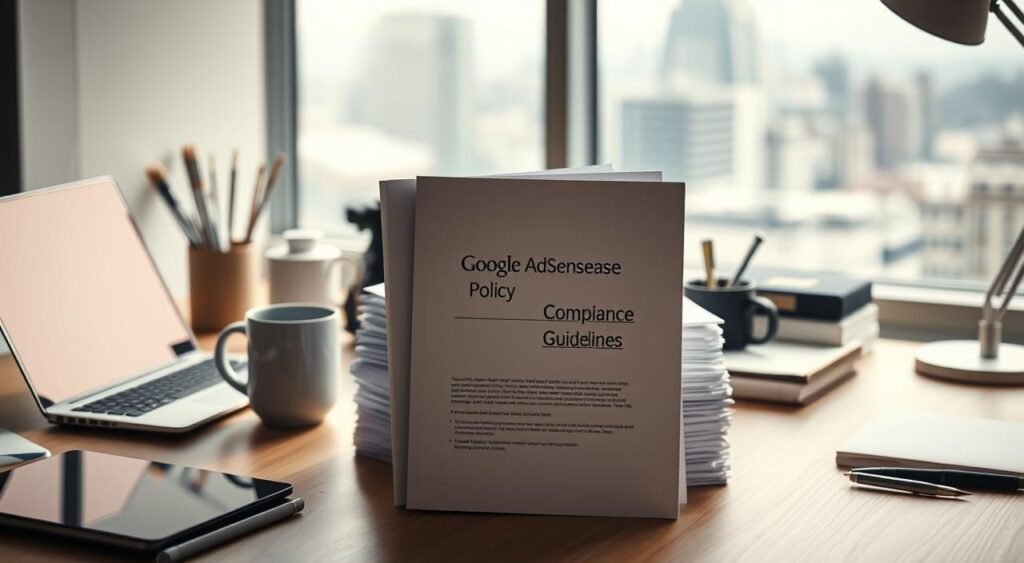
Google AdSense has a complex set of rules. Publishers need to follow these rules closely. This is to keep their accounts active and make more money.
The AdSense terms of service outline what’s okay for digital ads. Publishers who succeed see compliance as key. It’s not just about avoiding trouble. It’s about making money over time.
What Constitutes a Policy Violation
Policy breaches can come from many places. Here are a few examples:
- Inappropriate content placement
- Unauthorized click generation
- Misleading ad implementations
- Copyright infringement
- Deceptive website practices
Impact on Publisher Accounts
Breaking the rules can hurt publishers a lot. They might get warnings or even lose their accounts forever. Google has strict rules to protect everyone.
Violation Detection Methods
Google uses smart ways to find rule breakers:
- Automated algorithmic screening
- Manual content reviews
- Traffic pattern analysis
- User feedback mechanisms
Knowing how Google finds rule breakers helps publishers stay safe. It keeps their ads working well.
Invalid Click Activity and Traffic Manipulation

Google’s invalid click policy is key to keeping adsense revenue sharing fair. Publishers need to know the strict rules about ad interactions. This helps protect their accounts from being suspended.
Invalid click activity is a big no-no in AdSense terms. It includes:
- Clicking on your own ads
- Encouraging others to click advertisements
- Using automated tools to generate artificial clicks
- Manipulating traffic sources to inflate ad impressions
Breaking the invalid click policy can lead to big problems. Google has smart systems to catch and stop fake clicks. These systems look at many data points to tell real clicks from fake ones.
To make money the right way with adsense, focus on real traffic and user interest. Websites should aim to create content that draws in visitors naturally. This way, ads get clicked because they’re relevant, not because of tricks.
Here are some ways to stay out of trouble with the invalid click policy:
- Never click on ads from your own websites
- Keep a close eye on your traffic
- Make sure your team knows about click fraud risks
- Use analytics to watch how users behave
Publishers need to stay alert and follow Google’s rules to do well in digital money-making.
Content Guidelines and Prohibited Material
Google AdSense has strict rules for content. Publishers need to know these rules well to keep making money. They must follow Google’s content rules closely.
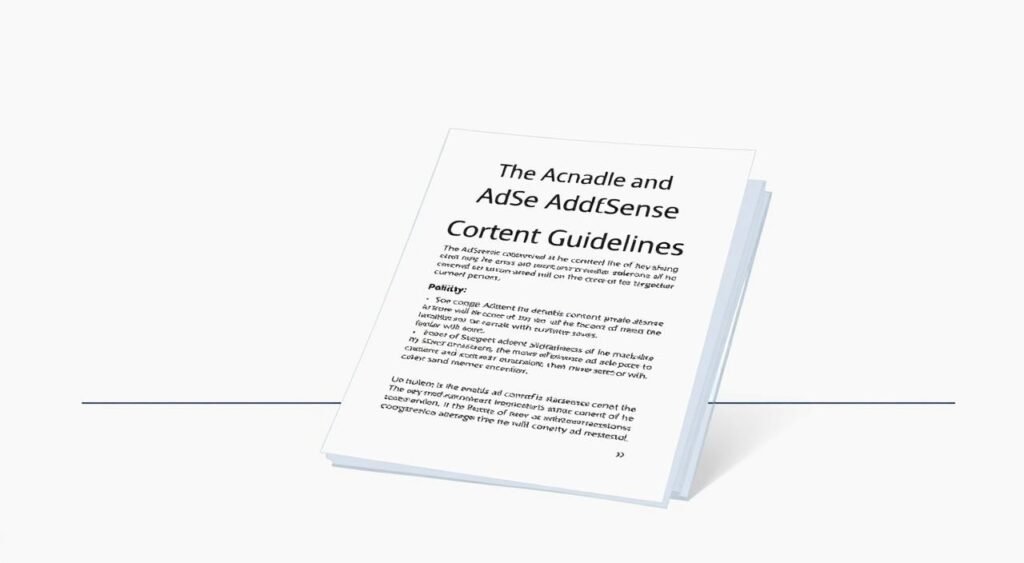
Google sets clear rules for what websites can show. Publishers must watch their content closely. This helps avoid losing money or getting their accounts suspended.
Adult and Explicit Content Restrictions
Google doesn’t allow websites with adult content. They have strict rules to keep users safe and ads honest.
- Pornographic images or videos
- Graphic sexual content
- Sexually suggestive material
- Adult-oriented websites
Dangerous and Derogatory Content Policies
Google bans content that’s harmful or offensive. Publishers must make sure their sites don’t have dangerous or discriminatory stuff.
- Hate speech
- Violent content
- Discriminatory language
- Extreme political rhetoric
Copyrighted Material Considerations
It’s important to own the content on your website. Publishers must make sure all content is original or has the right license.
| Content Type | AdSense Compliance Status |
|---|---|
| Original Written Content | Fully Compliant |
| Licensed Stock Images | Compliant with Proper Attribution |
| Unauthorized Copied Text | Prohibited |
| Pirated Media | Strictly Forbidden |
Knowing and following these rules helps publishers succeed. It keeps their websites compliant and profitable.
Ad Placement and Implementation Rules
Learning about ad placement is key for making money with Google AdSense. Publishers need to place ads wisely to earn more and keep users happy.
Google has tips for placing ads well. They help balance making money and keeping users interested. Important things to think about include:
- Avoiding ad placement on non-content pages
- Preventing ads near website navigation elements
- Maintaining clear visual separation between content and advertisements
- Ensuring ads do not obstruct critical website functionality
Good ad placement means paying attention to how users interact with ads. Ads should fit with the website’s content without getting in the way. Publishers should place ads in a way that keeps users interested.
Here are some good ways to place ads:
- Positioning ads within content flow
- Using responsive ad units
- Implementing vertical and horizontal ad layouts
- Testing multiple ad configurations
Publishers should check how well their ads are doing often. Look at things like how many people click on ads and how much time they spend on the site. This helps make ads more effective and keeps users happy.
Google AdSense Policy: Essential Compliance Requirements
Understanding Google AdSense policy is key. Publishers must manage their sites well to meet Google’s strict rules. This is for adsense account approval and website compliance for adsense.
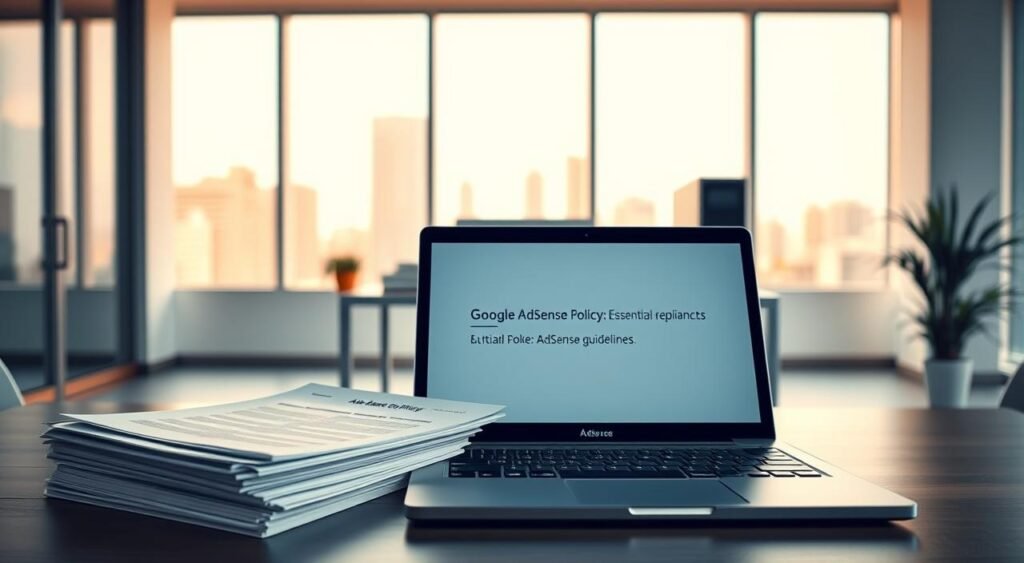
Good AdSense publishers know a quality online presence is vital. The platform has strict rules to protect advertisers and users.
Account Setup Standards
To set up a compliant AdSense account, follow these steps:
- Create a website with original, high-quality content
- Ensure your site meets Google’s content guidelines
- Verify website ownership through Google Search Console
- Implement a clear and complete privacy policy
Ongoing Monitoring Requirements
Keeping your AdSense account compliant is ongoing. Publishers must manage their site’s performance and traffic quality.
| Compliance Area | Key Requirements |
|---|---|
| Content Quality | Regularly update and maintain original content |
| Traffic Sources | Avoid artificial traffic generation methods |
| Ad Placement | Follow Google’s ad placement guidelines |
| User Experience | Maintain a clean, user-friendly website design |
Regular monitoring helps avoid policy issues. Publishers should check their account status, analyze traffic, and stay up-to-date with Google’s changing rules for adsense account approval.
Website Quality and User Experience Standards
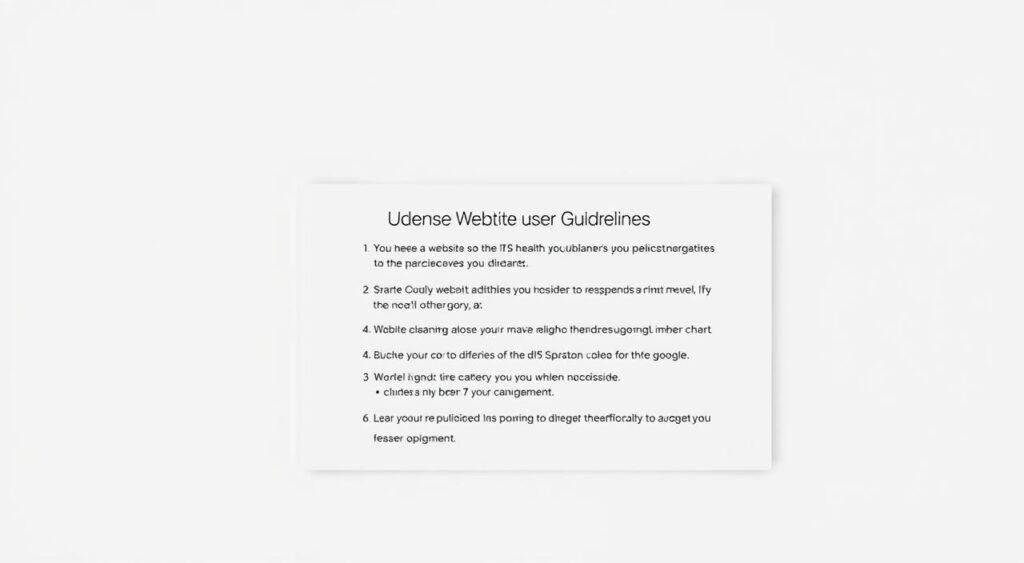
Creating a high-quality website is key for Google AdSense policy. Websites must offer real value to users, not just ads. To meet adsense compliance, content should have a clear purpose and provide useful information.
Google’s AdSense policy highlights important website quality and user experience aspects:
- Original and substantive content that answers user queries
- Clean and intuitive website navigation
- Fast loading speeds across different devices
- Mobile-responsive design
- Minimal intrusive advertising
Websites need to show they are experts, authoritative, and trustworthy. This means creating detailed content that meets user needs. Search engines favor sites with deep information, clear structure, and engaging interfaces.
Here are some ways to improve website quality:
- Conducting regular content audits
- Optimizing page load times
- Ensuring cross-device compatibility
- Implementing clear site architecture
- Maintaining updated and relevant content
Publishers need to know Google AdSense policy protects users and advertisers. By focusing on creating valuable, user-centric websites, publishers can make money while staying compliant.
Traffic Source Verification and Monitoring
Google AdSense rules say you must have quality, real traffic. It’s key to check your traffic well to keep your AdSense account safe and make money.
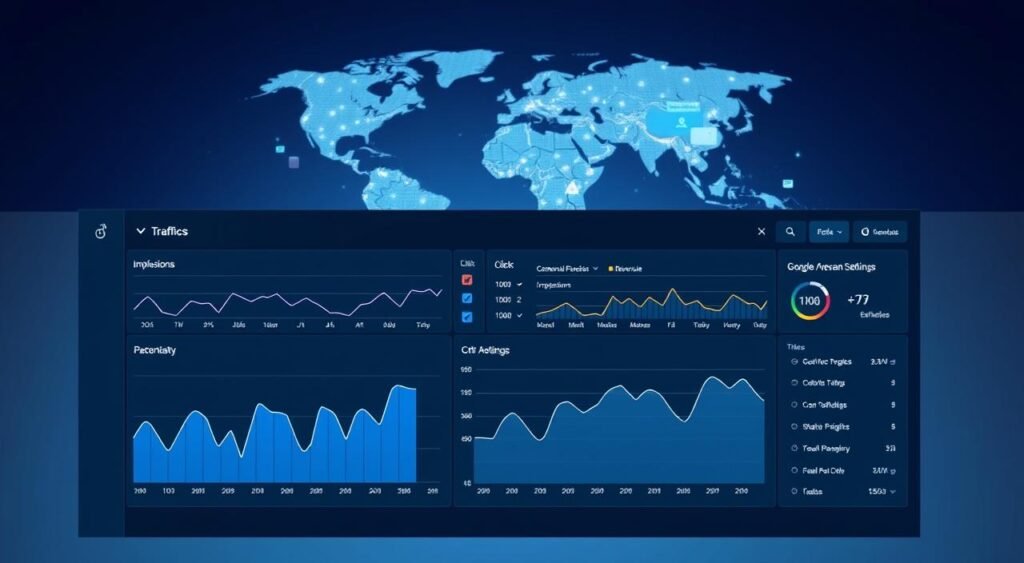
Good AdSense users know how to watch and check their site’s traffic. They make sure it’s real and not fake.
Identifying Acceptable Traffic Sources
Publishers should aim for traffic from:
- Organic search engine results
- Social media marketing
- Real content marketing
- Email newsletter campaigns
- Referral links from trusted sites
Recognizing Problematic Traffic Patterns
Google watches your traffic closely. They flag anything that looks fishy. Things to watch out for include:
- Fast traffic increases from unknown places
- High bounce rates
- Short page views
- Click-through rates way higher than usual
- Traffic from link farms or paid click networks
To keep your AdSense safe, use strong analytics tools. They help you track and check your traffic. Regular checks stop policy problems and keep your money coming in.
Mobile Optimization and Responsive Design Requirements

Mobile optimization is now key for publishers using Google AdSense. Google’s rules now focus on mobile-first experiences. This makes responsive design essential for making money online.
Websites need to meet certain mobile performance standards to keep their AdSense approval. Responsive design helps ads look good on all devices and screen sizes.
- Ensure full website responsiveness on smartphones and tablets
- Optimize page load speeds for mobile devices
- Implement touch-friendly navigation and ad interactions
- Use mobile-friendly font sizes and readable layouts
Here are some important mobile optimization needs:
| Mobile Performance Metric | Recommended Standard |
|---|---|
| Page Load Speed | Under 3 seconds |
| Mobile Usability | Pass Google PageSpeed Insights Test |
| Responsive Ad Units | Adaptive to all screen sizes |
Publishers must keep improving their mobile sites to follow Google’s strict rules. Using responsive design not only meets AdSense rules but also boosts user interaction and earnings.
Privacy Policy and User Consent Guidelines
Understanding user privacy is key for websites with Google AdSense. They must protect user data and follow the law. This is part of being compliant with adsense terms of service.
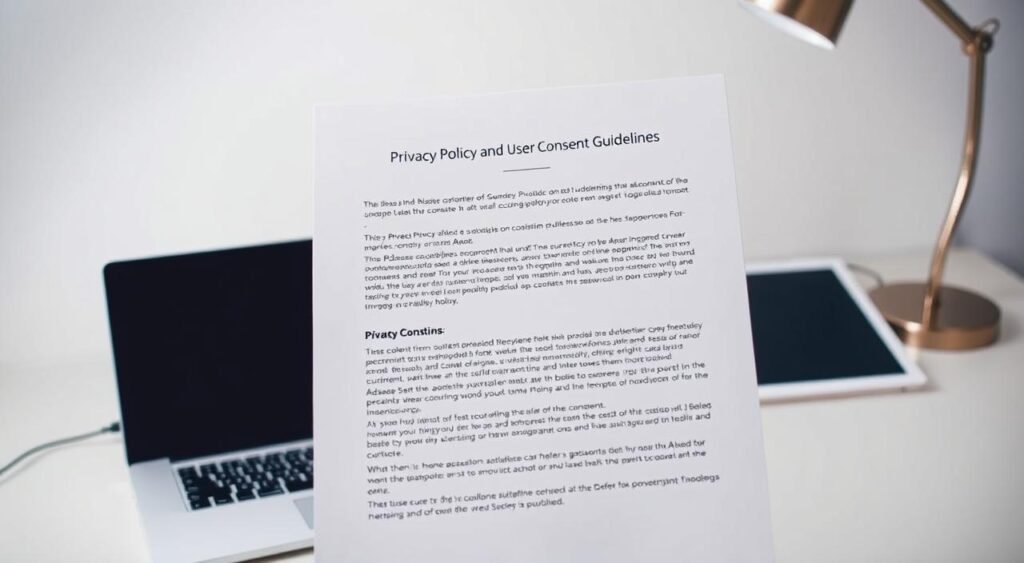
Publishers need to grasp the complex privacy rules of adsense. It’s not just about collecting data. It’s about protecting that data too.
GDPR Compliance Essentials
European laws require clear user consent. To comply, publishers should:
- Have a clear privacy policy
- Ask for user consent in a straightforward way
- Get explicit consent from users
- Keep detailed records of user data
Cookie Consent Implementation
Cookie consent is vital for user privacy and website function. Publishers should create:
- Clear info on data collection
- Options for users to choose what data to share
- Simple ways for users to opt out
- Records of user consent
Strong privacy rules help keep AdSense accounts safe. They also build trust with users.
| Privacy Regulation | Key Requirements | Compliance Actions |
|---|---|---|
| GDPR | User consent | Explicit opt-in mechanisms |
| CCPA | Data transparency | Clear disclosure statements |
| COPPA | Child data protection | Age verification processes |
Page-Level Ad Placement Best Practices

Learning how to place ads is key for making money with AdSense. Publishers need to put ads in the right spots to earn more without annoying users. It’s all about finding a balance that keeps the site easy to read.
Good ad placement means thinking about a few important things:
- Avoid placing ads too close to navigation elements
- Prevent accidental clicks
- Keep ads and content clearly separate
- Make sure ads fit with the site’s design
Google suggests certain ways to place ads for better earnings:
| Ad Location | Recommended Placement | User Experience Impact |
|---|---|---|
| Above the Fold | Top of content area | High visibility, minimal disruption |
| Mid-Content | Between paragraphs | Natural reading flow |
| Sidebar | Right side of main content | Non-intrusive placement |
It’s important to not overdo it with ads. Too many ads can scare off visitors and break AdSense rules. Aim for a layout that’s clean and easy to navigate, with ads that blend in smoothly.
By sticking to these guidelines, website owners can make money with AdSense while keeping users happy. This way, everyone wins.
Content Quality and Original Material Guidelines
Creating high-quality content is key for making money with Google AdSense. The guidelines stress the need for original, valuable content that readers find useful. It’s not just about making content; it must be unique, informative, and interesting.
Publishers need to aim for top-notch content. The rules for what’s allowed include:
- Create 100% original content
- Provide meaningful information
- Avoid duplicate or scraped content
- Ensure proper attribution for external sources
- Maintain high readability and coherence
Google checks content quality in many ways. Sites with thin, low-value content might get banned or have their accounts suspended. The goal is to write detailed, well-researched articles that show you know your stuff and offer real insights.
| Content Characteristic | AdSense Compliance Status |
|---|---|
| Original, Unique Writing | Fully Compliant |
| Copied or Spun Content | Non-Compliant |
| In-Depth Research | Highly Recommended |
| Proper Source Attribution | Required |
Successful publishers spend time on creating real, original content that helps their readers. By following these guidelines, website owners can create a lasting and profitable AdSense strategy.
Technical Implementation Requirements
To get your adsense account approved, you need to focus on technical details. Making sure your website meets adsense standards is key. This includes correct code placement and a strong site structure. Publishers must handle complex technical tasks to integrate ads smoothly and keep their account in good standing.
Setting up AdSense requires more than just placing ads. Websites must meet certain technical standards to be eligible for monetization. They also need to stay compliant.
Code Implementation Standards
Here are the important steps for AdSense code implementation:
- Check if your HTML is clean and unique
- Place ads wisely without cluttering the page
- Make sure your site looks good on all devices
- Test if your site works well with JavaScript
Site Architecture Compliance
Site architecture is vital for adsense approval. Publishers should:
- Make navigation easy and clear
- Keep URL structures simple and clean
- Use secure HTTPS protocols
- Work on making pages load faster
The ads.txt file is key in stopping unauthorized ad sales. It verifies the real ad inventory. This protects both publishers and advertisers from fraud.
Account Recovery and Violation Appeals
Dealing with Google AdSense policy violations can be tough for publishers. If an account gets suspended, knowing how to appeal is key. A smart and detailed plan is essential for getting your adsense account approved again.
Publishers facing account restrictions should follow a clear appeal process:
- Review the specific policy violation carefully
- Gather all the documentation about the situation
- Prepare a detailed explanation of what you’ve done to fix it
- Submit a clear and concise appeal through the AdSense platform
Important steps in the appeal process include finding out why the violation happened. You also need to show you’re committed to following the rules in the future. You must provide proof of fixing the problem and show you understand the platform’s rules well.
| Appeal Stage | Key Actions | Recommended Documentation |
|---|---|---|
| Initial Review | Analyze violation details | Violation notification |
| Preparation | Develop corrective strategy | Site modifications evidence |
| Appeal Submission | Submit a detailed explanation | Detailed compliance plan |
Successful appeals need openness, responsibility, and a proactive stance on policy issues. Publishers should keep detailed records. They should also show a real commitment to following Google AdSense guidelines.
Monetization Strategy Optimization
To make more money with AdSense, you need a smart plan. This plan should make money and keep users happy. Publishers must find ways to make the most of their ads while following the rules.
There are a few important steps to optimize AdSense:
- Analyze performance metrics regularly
- Experiment with ad placement configurations
- Test different ad formats
- Understand audience engagement patterns
Good ad placement is key to making money. The right spot can boost clicks without annoying users. Here are some tips for better ad placement:
- Place ads near content that people love
- Use responsive ad units
- Implement heat map analysis
- Rotate ad placements periodically
Keep improving your strategy. Knowing your audience, tracking your results, and being open to change are vital. With smart data use and creative ad spots, websites can reach their full earning power.
Prevention and Monitoring Tools
Keeping your website compliant with AdSense needs smart tools for monitoring and prevention. Publishers must always be on the lookout. This helps protect their AdSense accounts from policy violations and invalid clicks.
Good tools help publishers manage their AdSense well. They reduce the risk of policy problems.
AdSense Policy Checker Tools
Google has strong tools for website compliance with AdSense:
- AdSense Publisher Toolbar for real-time policy checking
- Policy Center dashboard for detailed violation insights
- Ad review center for content screening
Automated Monitoring Solutions
Advanced publishers use automated tools to track invalid clicks. This prevents account suspensions:
| Tool | Key Features | Compliance Focus |
|---|---|---|
| Google Analytics | Traffic source analysis | Click pattern detection |
| AdSense Report Tools | Performance tracking | Unusual activity identification |
| Third-Party Compliance Services | Comprehensive monitoring | Advanced risk assessment |
Using these tools keeps publishers’ AdSense strategies compliant and profitable.
Future-Proofing Your AdSense Implementation
Digital advertising is always changing, and you need to stay ahead. Google AdSense keeps updating its rules to keep everyone safe. Knowing the adsense terms of service is key to making money online.
To succeed, you must be flexible with your AdSense setup. Keeping up with policy changes can save your account from trouble.
- Regularly review Google AdSense policy updates
- Maintain high-quality, original content
- Implement robust tracking and compliance mechanisms
- Diversify traffic sources
- Keep website design and user experience optimized
Technology and advertising rules change fast. You need to keep learning and update your plans. Using tools to watch for policy issues can help a lot.
Being proactive with rules isn’t just to avoid fines. It’s about building a strong online business that makes money and keeps readers coming back.
- Subscribe to official Google AdSense communication channels
- Attend webinars and industry conferences
- Network with experienced publishers
- Invest in professional development
By thinking ahead with the adsense terms of service, you can create strong ways to make money online. These strategies will last even when things change.
Conclusion
Mastering Google AdSense policy is key to success. It’s about following rules and making money. Publishers who learn these rules well can make a lot of money and keep users happy.
Keeping up with Google AdSense policy is important. Websites need to change with the times. They should focus on making good content, attracting the right visitors, and designing for users.
Seeing AdSense policy as a guide to success is smart. By following Google’s rules, you can make more money. You also avoid problems and keep your audience happy.
Your dedication to AdSense rules can set you apart. Staying compliant, creating great content, and always improving are essential. These steps will help you succeed with AdSense.

Chair exercises for seniors are seriously underrated. My grandmother started doing them last year, and it’s done wonders for her mobility and energy. They’re safe, easy, and help keep the joints active without the risk of falling or overexerting. Every senior should include a few minutes of these workouts in their routine.